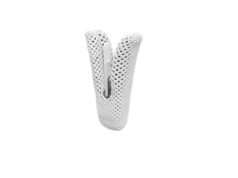
One-year results from the TRILUMINATE study show that TriClip (Abbott) transcatheter therapy for symptomatic moderate or greater tricuspid regurgitation (TR) results in durable reduction of regurgitation, with few major adverse events, and improvement in functional and clinical outcomes.
Phillip Lurz presented the findings at PCR e-Course 2020 (25–27June), and indicated: “These results suggest transcatheter therapy for the treatment of TR is a safe and effective alternative to surgery, especially in this high-risk population.”
Introducing, he said: “This trial investigated the safety and effectiveness of percutaneous edge-to-edge repair for TR using the TriClip device. The TRILUMINATE trial is a prospective, single-arm, multicentre study conducted at 21 sites in Europe and the USA, enrolling 85 subjects. Primary safety and effectiveness endpoints at 30 days were successfully met, and we now report the longer-term outcomes, including repair durability, clinical benefit, and safety at one year.”
In regard to durability of repair, the acute reduction in tricuspid regurgitation was “very well maintained” at one year, he said; “the percentage of patients with moderate or less tricuspid regurgitation even increased from 60% at 30 days over time to one year up to 70%.”
A five-grade TR scheme was employed in the study, Lurz pointed out, which meant that, “some patients started off at baseline with a TR grade of 5 and then had a reduction to TR grade 3 at one year, meaning that those patients had two grades of TR reduced”. At least 87.1% showed an improvement of one grade or more at one year, and 71% had a reduction of at least two grades.
“Overall, these results were achieved with very few safety concerns,” he added. “There was a total of six major events and, out of those, four were classified as cardiovascular. All-cause mortality was low at 71%, and this is certainly a fragile and high-risk population.”
The reduction in TR was accompanied by early and sustained symptomatic improvement and New York Heart Association (NYHA) class (83% in NYHA I/II at one year vs. 31% at baseline, p<0.0001), as well as continued improvement in quality of life, as measured by the Kansas City Cardiomyopathy Questionnaire (KCCQ; improvement of 20 points, 95% confidence interval 15–25, p<0.0001).
Echocardiography corelab analysis indicated evidence of positive right ventricular remodelling, with an early significant reduction in RV size from baseline to 30 days, and an additional reduction between 30 days and one year. An initial increase in RV function at 30 days was followed by “a significant improvement” from 30 days to one year, suggesting, said Lurz, “a positive physiological response to TR reduction”.
The rate of hospitalisation was reduced by 40% from one-year pre-procedure to one-year post-procedure, and patients who had moderate or less TR at 30 days had significantly lower incidence of the combined endpoint of death and hospitalisation than patients with severe or greater TR at 30 days (HR 0.31).
Lurz concluded: “Percutaneous edge-to-edge repair for tricuspid regurgitation in the TRILUMINATE trial resulted in a durable repair, with TR reduction of at least one grade in 87.1% at one year. This was achieved with, overall, a very low major adverse event rate at one year, 7.1%. TR reduction was associated with sustained symptomatic improvements, alongside robust quality of life improvements, consistent signs of reverse right ventricular remodelling, and a reduced hospitalisations rate at one year.”
Putting the findings into context, Lurz told Cardiovascular News: “Despite a positive signal of tricuspid valve edge-to-edge repair from the very beginning, there were always discussions and concerns about durability, plus the implications for right ventricular function, and the clinical benefit of reducing tricuspid regurgitation. We now have evidence that tricuspid valve repair is durable, even improves right ventricular function, and results in clear clinical benefits with less hospitalisation after treatment. Some questions remain, but these first important answers will support the whole field of tricuspid valve intervention when moving forward.”












